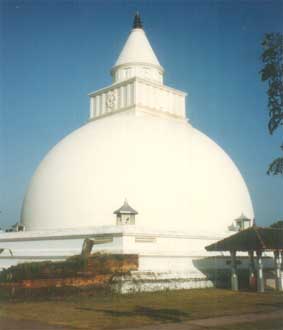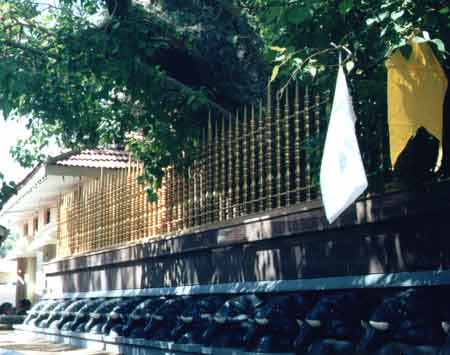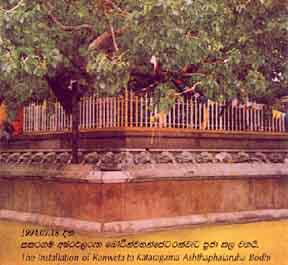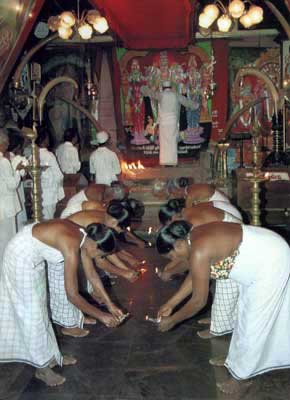|
| |||||||||

Kirivehera at Kataragamaby Premasara Epasinghe
Out of the Solosmastana, (sixteen sacred places of worship sites) in Sri Lanka, Kirivehera at Kataragama in the Southern Province is prominent. According to the historical evidence, Kirivehera was known as Magulmahaseya. The chronicles as well as Samanthapasadika and Pujavaliya mentions that the Blessed One - Gautama Buddha in His third visit to Sri Lanka, visited Kataragama,known as Kajaragama and stayed at a place called "Kihiriuana". Most probably Kirhiriuyana was the site, where lies the majestic, resplendent Kirivehera Chaitya today. Undoubtedly, Kirivehera is one of the most sacred Buddhist religious sites in the island. Most of the devotees, of all religions Buddhists, Hindus, Catholics, Christians, Muslims, visit the historic Kataragama Devalaya, for vows. They, make it a point to visit Kirivehera, which is in very close proximity to Kataragama Devalaya.
The Esela Perahera, at Kataragama will commence on 3rd and will end on 18th July 2008. Kataragama Devalaya is dedicated to God Skanda, the Hindu God of War, known locally as "Kataragama Deiyo". For this annual festival a large number if Buddhist, Hindus and even Muslims attend. They cleanse themselves in the holy waters of the Menik Ganga and offer flowers, incense and fruits at the shrine. During the festival season, acts of self mortification, especially by the Hindus is very common. "Kavadi" dancing, walking on red hot embers barefoot are performed by devotees, much to the awe of the onlookers. Kataragama, has visitors daily has an exotic atmosphere laced with religious fervors. Kataragama Devalaya, where "Astapalabodhi" Tree stands and Kataragama Kirivehera are inseparable. Out of the high ranking duty official numbering 56 who perform various religious rites and rituals at the Kataragama Devalaya, the most important and prestigious position is known at the "Pirith Nilaya" (Monks who chant Pirith). This is traditionally assigned to the Buddhist monks attached to Kirivehera Temple from time immemorial. According to the legend, Kirivehera Chaitya was constructed by a Sinhala Ruler Mahanaga, during the 3rd Century B.C. During the early period, it took the shape of a Bell, Today its in the shape of a Bubble. (Bubbulakara). It is mentioned that in the Kirivehera Stupa, there lies the "Hair Relic" and the "Pathkada" (Piece of Cloth), the Blessed One used when He sat in the Kirivehera compound. Reference is mentioned in the "Kataragama Abhilekanya" which is supposed to be the work of King Mahadhattika Mahanaga about Kataragama. In this document, Kataragama is named as Kajaragama or Kaccharagama. Further, in the "Neelakobo Sandeshaya" the messenger bird states that he pictures Kirivehera Chaitya like a "Sudupenabubulak" which means a white bubble. In another document, it reveals that the Kirivehera reconstruction were carried out by, an Upasaka named Siribaddana. Today, one can picture the panoramic, majestic Kirivehera Stupa with its beautiful spire, silhouetted against the azure blue sky. We must mention here with gratitude the great yeomen services rendered for the development of Kirivehera Chaitya and the facilities provided today to the pilgrims and devotees by the Chief Incumbent of Kirivehera Rajamaha Viharaya - the Chancellor if the University of Uva-Wellassa, Dr. Aluthwewe Soratha Mahanayaka Thero. Courtesy: The Sunday Observer of 29 June 2008See also:
|




